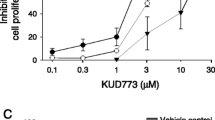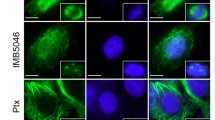Abstract
Purpose
Microtubules are one of the most useful subcellular targets in chemotherapy. We identified a novel indole, (3-(1H-indol-2-yl)phenyl)(1H-indol-2-yl)methanone (15), that inhibits tubulin action and exhibits potent antitumor activity in various preclinical models.
Methods
In vitro cancer cell growth inhibition was measured by SRB or MTT assay in human cancer cell lines. Apoptosis induced by 15 was examined in LNCaP and PC-3 cells. Effects of 15 on cell cycle distribution and tubulin were investigated via in vitro models. In vivo toxicity and xenograft efficacy studies were conducted in mice.
Results
Indole 15 inhibited the in vitro growth of a number of human cancer cell lines, including drug-resistant cell lines that over-express P-glycoprotein, multidrug resistance-associated proteins, and breast cancer resistance protein with IC50 values in the range of 34–162 nM. Nanomolar concentrations of the compound caused down-regulation of bcl-2, induced PARP cleavage, and induced apoptosis in both LNCaP and PC-3 prostate cancer cells, as confirmed by anti-histone ELISA and DNA laddering. In vitro studies revealed that the compound inhibited polymerization of purified tubulin and induced a strong and concentration-dependent G2M arrest in PC-3 cells. In vivo studies in immunodeficient mice bearing PC-3 tumor xenografts showed that the compound effectively inhibited tumor growth.
Conclusions
The potent in vitro and in vivo antitumor activities of this novel indole suggest that drugs with this novel chemical scaffold might be developed for treatment of drug-resistant prostate cancer.




Similar content being viewed by others
Abbreviations
- MRP:
-
Multidrug resistance-associated proteins
- BCRP:
-
Breast cancer resistance protein
- MDR:
-
Multidrug resistance
- ABC:
-
ATP-binding cassette
- SRB:
-
Sulforhodamine B
- MTT:
-
3-(4,5-Dimethylthiazol-2-yl)-2,5-diphenyltetrazolium bromide
- FACS:
-
Fluorescence-activated cell sorting
- MTD:
-
Maximally tolerated dose
- T/C:
-
Treated over control tumor volume ratio × 100%
References
Dumontet C, Sikic BI (1999) Mechanisms of action of and resistance to antitubulin agents: microtubule dynamics, drug transport, and cell death. J Clin Oncol 17:1061–1070
Tannock IF, de Wit R, Berry WR, Horti J, Pluzanska A, Chi KN, Oudard S, Theodore C, James ND, Turesson I et al (2004) Docetaxel plus prednisone or mitoxantrone plus prednisone for advanced prostate cancer. N Engl J Med 351:1502–1512
Malik B, Stillman M (2008) Chemotherapy-induced peripheral neuropathy. Curr Neurol Neurosci Rep 8:56–65
Hamel E (1992) Natural products which interact with tubulin in the vinca domain maytansine, rhizoxin, phomopsin A, dolastatins 10 and 15 and halichondrin B. Pharmacol Ther 55:31–51
Verrills NM, Kavallaris M (2005) Improving the targeting of tubulin-binding agents: lessons from drug resistance studies. Curr Pharm Des 11:1719–1733
Sanchez C, Mendoza P, Contreras HR, Vergara J, McCubrey JA, Huidobro C, Castellon EA (2009) Expression of multidrug resistance proteins in prostate cancer is related with cell sensitivity to chemotherapeutic drugs. Prostate 69:1448–1459
Leonard GD, Fojo T, Bates SE (2003) The role of ABC transporters in clinical practice. Oncologist 8:411–424
Chou TC, O’Connor OA, Tong WP, Guan Y, Zhang ZG, Stachel SJ, Lee C, Danishefsky SJ (2001) The synthesis, discovery, and development of a highly promising class of microtubule stabilization agents: curative effects of desoxyepothilones B and F against human tumor xenografts in nude mice. Proc Natl Acad Sci USA 98:8113–8118
Lin B, Catley L, LeBlanc R, Mitsiades C, Burger R, Tai YT, Podar K, Wartmann M, Chauhan D, Griffin JD, Anderson KC (2005) Patupilone (epothilone B) inhibits growth and survival of multiple myeloma cells in vitro and in vivo. Blood 105:350–357
Lee FY, Borzilleri R, Fairchild CR, Kim SH, Long BH, Reventos-Suarez C, Vite GD, Rose WC, Kramer RA (2001) BMS-247550 a novel epothilone analog with a mode of action similar to paclitaxel but possessing superior antitumor efficacy. Clin Cancer Res 7:1429–1437
Beckers T, Reissmann T, Schmidt M, Burger AM, Fiebig HH, Vanhoefer U, Pongratz H, Hufsky H, Hockemeyer J, Frieser M, Mahboobi S (2002) 2-aroylindoles, a novel class of potent, orally active small molecule tubulin inhibitors. Cancer Res 62:3113–3119
Chou TC, Zhang XG, Harris CR, Kuduk SD, Balog A, Savin KA, Bertino JR, Danishefsky SJ (1998) Desoxyepothilone B is curative against human tumor xenografts that are refractory to paclitaxel. Proc Natl Acad Sci USA 95:15798–15802
Giannakakou P, Sackett DL, Kang YK, Zhan Z, Buters JT, Fojo T, Poruchynsky MS (1997) Paclitaxel-resistant human ovarian cancer cells have mutant beta-tubulins that exhibit impaired paclitaxel-driven polymerization. J Biol Chem 272:17118–17125
Letourneau IJ, Slot AJ, Deeley RG, Cole SP (2007) Mutational analysis of a highly conserved proline residue in MRP1, MRP2, and MRP3 reveals a partially conserved function. Drug Metab Dispos 35:1372–1379
Tsuruo T, Iida-Saito H, Kawabata H, Oh-hara T, Hamada H, Utakoji T (1986) Characteristics of resistance to adriamycin in human myelogenous leukemia K562 resistant to adriamycin and in isolated clones. Jpn J Cancer Res 77:682–692
Fang L, Zhang G, Li C, Zheng X, Zhu L, Xiao JJ, Szakacs G, Nadas J, Chan KK, Wang PG, Sun D (2006) Discovery of a daunorubicin analogue that exhibits potent antitumor activity and overcomes P-gp-mediated drug resistance. J Med Chem 49:932–941
Chen C, Okayama H (1987) High-efficiency transformation of mammalian cells by plasmid DNA. Mol Cell Biol 7:2745–2752
Robey RW, Honjo Y, Morisaki K, Nadjem TA, Runge S, Risbood M, Poruchynsky MS, Bates SE (2003) Mutations at amino-acid 482 in the ABCG2 gene affect substrate and antagonist specificity. Br J Cancer 89:1971–1978
Bacher G, Nickel B, Emig P, Vanhoefer U, Seeber S, Shandra A, Klenner T, Beckers T (2001) D-24851, a novel synthetic microtubule inhibitor, exerts curative antitumoral activity in vivo, shows efficacy toward multidrug-resistant tumor cells, and lacks neurotoxicity. Cancer Res 61:392–399
Dethlefsen LA, Prewitt JM, Mendelsohn ML (1968) Analysis of tumor growth curves. J Natl Cancer Inst 40:389–405
Schinkel AH, Jonker JW (2003) Mammalian drug efflux transporters of the ATP binding cassette (ABC) family: an overview. Adv Drug Deliv Rev 55:3–29
Fares FA, Ge X, Yannai S, Rennert G (1998) Dietary indole derivatives induce apoptosis in human breast cancer cells. Adv Exp Med Biol 451:153–157
Ge X, Fares FA, Yannai S (1999) Induction of apoptosis in MCF-7 cells by indole-3-carbinol is independent of p53 and bax. Anticancer Res 19:3199–3203
Mahboobi S, Sellmer A, Eichhorn E, Beckers T, Fiebig HH, Kelter G (2005) Synthesis and cytotoxic activity of 2-acyl-1H-indole-4,7-diones on human cancer cell lines. Eur J Med Chem 40:85–92
Kuo CC, Hsieh HP, Pan WY, Chen CP, Liou JP, Lee SJ, Chang YL, Chen LT, Chen CT, Chang JY (2004) BPR0L075, a novel synthetic indole compound with antimitotic activity in human cancer cells, exerts effective antitumoral activity in vivo. Cancer Res 64:4621–4628
Liou JP, Wu CY, Hsieh HP, Chang CY, Chen CM, Kuo CC, Chang JY (2007) 4- and 5-aroylindoles as novel classes of potent antitubulin agents. J Med Chem 50:4548–4552
Liou JP, Wu ZY, Kuo CC, Chang CY, Lu PY, Chen CM, Hsieh HP, Chang JY (2008) Discovery of 4-amino and 4-hydroxy-1-aroylindoles as potent tubulin polymerization inhibitors. J Med Chem 51:4351–4355
Usui T, Kondoh M, Cui CB, Mayumi T, Osada H (1998) Tryprostatin A, a specific and novel inhibitor of microtubule assembly. Biochem J 333(Pt 3):543–548
Mahboobi S, Pongratz H, Hufsky H, Hockemeyer J, Frieser M, Lyssenko A, Paper DH, Burgermeister J, Bohmer FD, Fiebig HH et al (2001) Synthetic 2-aroylindole derivatives as a new class of potent tubulin-inhibitory, antimitotic agents. J Med Chem 44:4535–4553
Haldar S, Basu A, Croce CM (1997) Bcl2 is the guardian of microtubule integrity. Cancer Res 57:229–233
Kraus LA, Samuel SK, Schmid SM, Dykes DJ, Waud WR, Bissery MC (2003) The mechanism of action of docetaxel (Taxotere) in xenograft models is not limited to bcl-2 phosphorylation. Invest New Drugs 21:259–268
Morris PG, Fornier MN (2008) Microtubule active agents: beyond the taxane frontier. Clin Cancer Res 14:7167–7172
Peterson JK, Tucker C, Favours E, Cheshire PJ, Creech J, Billups CA, Smykla R, Lee FY, Houghton PJ (2005) In vivo evaluation of ixabepilone (BMS247550), a novel epothilone B derivative, against pediatric cancer models. Clin Cancer Res 11:6950–6958
Le HT, Schaldach CM, Firestone GL, Bjeldanes LF (2003) Plant-derived 3,3′-diindolylmethane is a strong androgen antagonist in human prostate cancer cells. J Biol Chem 278:21136–21145
Acknowledgments
These studies were supported by grant #PC060380 from the Department of Defense Prostate Cancer Research Program of the US Army Medical Research and Materiel Command.
Author information
Authors and Affiliations
Corresponding author
Electronic supplementary material
Below is the link to the electronic supplementary material.
Rights and permissions
About this article
Cite this article
Ahn, S., Hwang, D.J., Barrett, C.M. et al. A novel bis-indole destabilizes microtubules and displays potent in vitro and in vivo antitumor activity in prostate cancer. Cancer Chemother Pharmacol 67, 293–304 (2011). https://doi.org/10.1007/s00280-010-1319-8
Received:
Accepted:
Published:
Issue Date:
DOI: https://doi.org/10.1007/s00280-010-1319-8




